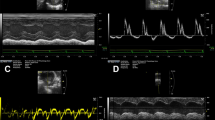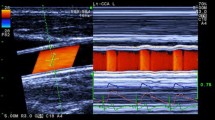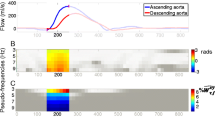Abstract
Mouse models are increasingly employed in the comprehension of cardiovascular disease. Wave Intensity Analysis (WIA) can provide information about the interaction between the vascular and the cardiac system. We investigate age-associated changes in WIA-derived parameters in mice and correlate them with biomarkers of cardiac function. Sixteen wild-type male mice were imaged with high-resolution ultrasound (US) at 8 weeks (T 0) and 25 weeks (T 1) of age. Carotid pulse wave velocity (PWV) was calculated from US images using the diameter–velocity loop and employed to evaluate WIA. Amplitudes of the first (W 1) and the second (W 2) local maxima, local minimum (W b) and the reflection index (RI = W b/W 1) were assessed. Cardiac output (CO), ejection fraction (EF), fractional shortening (FS) and stroke volume (SV) were evaluated; longitudinal, radial and circumferential strain and strain rate values (LS, LSR, RS, RSR, CS, CSR) were obtained through strain analysis. W 1 (T 0: 4.42e-07 ± 2.32e-07 m2/s; T 1: 2.21e-07 ± 9.77 m2/s), W 2 (T 0: 2.45e-08 ± 9.63e-09 m2/s; T 1: 1.78e-08 ± 7.82 m2/s), W b (T 0: −8.75e-08 ± 5.45e-08 m2/s; T 1: −4.28e-08 ± 2.22e-08 m2/s), CO (T 0: 19.27 ± 4.33 ml/min; T 1: 16.71 ± 2.88 ml/min), LS (T 0: 17.55 ± 3.67%; T 1: 15.05 ± 2.89%), LSR (T 0: 6.02 ± 1.39 s−1; T 1: 5.02 ± 1.25 s−1), CS (T 0: 27.5 ± 5.18%; T 1: 22.66 ± 3.09%) and CSR (T 0: 10.03 ± 2.55 s−1; T 1: 7.50 ± 1.84 s−1) significantly reduced with age. W 1 was significantly correlated with CO (R = 0.58), EF (R = 0.72), LS (R = 0.65), LSR (R = 0.89), CS (R = 0.61), CSR (R = 0.70) at T 0; correlations were lost at T 1. The decrease in W 1 and W 2 suggests a cardiac performance reduction, while that in Wb, considering unchanged RI, might indicate a wave energy decrease. The loss of correlation between WIA-derived and cardiac parameters might reflect an alteration in cardiovascular interaction.




Similar content being viewed by others
Abbreviations
- RelD:
-
Relative distension
- PWV:
-
Pulse wave velocity
- LVmass:
-
Left ventricular mass
- CO:
-
Cardiac output
- FS:
-
Fractional shortening
- SV:
-
Stroke volume
- EF:
-
Ejection fraction
- gLS:
-
Global longitudinal strain
- gLSR:
-
Global longitudinal strain rate
- gRS:
-
Global radial strain
- gRSR:
-
Global radial strain rate
- gCS:
-
Global circumferential strain
- gCSR:
-
Global circumferential strain rate
References
Russell JC, Proctor SD (2006) Small animal models of cardiovascular disease: tools for the study of the roles of metabolic syndrome, dyslipidemia, and atherosclerosis. Cardiovasc Pathol 15(6):318–330
Jones CJ, Goodfellow J, Bleasdale RA, Frenneaux MP (2000) Modulation of interaction between left ventricular ejection and the arterial compartment: assessment of aortic wave travel. Heart Vessels 15(6):247–255
MacRae JM, Sun YH, Isaac DL, Dobson GM, Cheng CP, Little WC, Parker KH, Tyberg JV (1997) Wave-intensity analysis: a new approach to left ventricular filling dynamics. Heart Vessels 12(2):53–59
Parker KH, Jones CJ, Dawson JR, Gibson DG (1988) What stops the flow of blood from the heart? Heart Vessels 4(4):241–245
Hughes AD, Parker KH, Davies JE (2008) Waves in arteries: a review of Wave Intensity analysis in the systemic and coronary circulations. Artery Res 2:51–59
Ohte N, Narita H, Sugawara M, Niki K, Okada T, Harada A, Hayano J, Kimura G (2003) Clinical usefulness of carotid arterial wave intensity in assessing left ventricular systolic and early diastolic performance. Heart Vessels 18(3):107–111
Khir AW, Henein MY, Koh T, Das SK, Parker KH, Gibson DG (2001) Arterial waves in humans during peripheral vascular surgery. Clin Sci (Lond) 101(6):749–757
Zambanini A, Cunningham SL, Parker KH, Khir AW, Thom SA, Hughes AD (2005) Wave-energy patterns in carotid, brachial, and radial arteries: a noninvasive approach using wave-intensity analysis. Am J Physiol Heart Circ Physiol 289(1):H270–H276
Sugawara M, Niki K, Ohte N, Okada T, Harada A (2009) Clinical usefulness of wave intensity analysis. Med Biol Eng Comput 47(2):197–206
Curtis S, Zambanini A, Mayet J, Mc G, Thom SA, Foale R, Parker KH, Hughes AD (2007) Reduced systolic wave generation and increased peripheral wave reflection in chronic heart failure. Am J Physiol Heart Circ Physiol 293(1):H557–H562
Penny DJ, Mynard JP, Smolich JJ (2008) Aortic wave intensity analysis of ventricular-vascular interaction during incremental dobutamine infusion in adult sheep. Am J Physiol Heart Circ Physiol 294(1):H481–H489
Khir AW, Zambanini A, Parker KH (2004) Local and regional wave speed in the aorta: effects of arterial occlusion. Med Eng Phys 26(1):23–29
Feng J, Khir AW (2010) Determination of wave speed and wave separation in the arteries using diameter and velocity. J Biomech 43(3):455–462
Borlotti A, Khir AW, Rietzschel ER, De Buyzere ML, Vermeersch S, Segers P (2012) Noninvasive determination of local pulse wave velocity and wave intensity: changes with age and gender in the carotid and femoral arteries of healthy human. J Appl Physiol 113(5):727–735
Gao S, Ho D, Vatner ED, Vatner SF (2011) Echocardiography in Mice. Curr Protoc Mouse Biol 1:71–83
Semeniuk LM, Severson DL, Kryski AJ, Swirp SL, Molkentin JD, Duff HJ (2003) Time-dependent systolic and diastolic function in mice overexpressing calcineurin. Am J Physiol Heart Circ Physiol 284:H425–H430
Bauer M, Cheng S, Jain M, Ngoy S, Theodoropoulos S, Trujillo A, Lin FC, Liao R (2011) Echocardiographic speckle-tracking based strain imaging for rapid cardiovascular phenotyping in mice. Circ Res 108(8):908–916
Cerqueira MD, Weissman NJ, Dilsizian V, Jacobs AK, Kaul S, Laskey WK, Pennell DJ, Rumberger JA, Ryan T, Verani MS; American Heart Association Writing Group on Myocardial Segmentation and Registration for Cardiac Imaging (2002) Standardized myocardial segmentation and nomenclature for tomographic imaging of the heart. A statement for healthcare professionals from the Cardiac Imaging Committee of the Council on Clinical Cardiology of the American Heart Association. Circulation 105(4):539–542
Chérin E, Williams R, Needles A, Liu G, White C, Brown AS, Zhou YQ, Foster FS (2006) Ultrahigh frame rate retrospective ultrasound microimaging and blood flow visualization in mice in vivo. Ultrasound Med Biol 32(5):683–691
Di Lascio N, Stea F, Kusmic C, Sicari R, Faita F (2014) Non-invasive assessment of pulse wave velocity in mice by means of ultrasound images. Atherosclerosis 237(1):31–37
Biglino G, Steeden JA, Baker C, Schievano S, Taylor AM, Parker KH, Muthurangu V (2012) A non-invasive clinical application of wave intensity analysis based on ultrahigh temporal resolution phase-contrast cardiovascular magnetic resonance. J Cardiovasc Magn Reson 14:57
Vriz O, Zito C, Di Bello V, La Carrubba S, Driussi C, Carerj S, Bossone E, Antonini-Canterin F (2016) Non-invasive one-point carotid wave intensity in a large group of healthy subjects: a ventricular-arterial coupling parameter. Heart Vessels 31(3):360–369
Chantler PD, Lakatta EG (2012) Arterial-ventricular coupling with aging and disease. Front Physiol 3:90
Bleasdale RA, Mumford CE, Campbell RI, Fraser AG, Jones CJ, Frenneaux MP (2003) Wave intensity analysis from the common carotid artery: a new noninvasive index of cerebral vasomotor tone. Heart Vessels 18(4):202–206
McEniery CM, Yasmin Hall IR, Qasem A, Wilkinson IB, Cockcroft JR, ACCT Investigators (2005) Normal vascular aging: differential effects on wave reflection and aortic pulse wave velocity: the Anglo-Cardiff Collaborative Trial (ACCT). J Am Coll Cardiol 46(9):1753–1760
Mitchell GF, van Buchem MA, Sigurdsson S, Gotal JD, Jonsdottir MK, Kjartansson O, Garcia M, Aspelund T, Harris TB, Gudnason V, Launer LJ (2011) Arterial stiffness, pressure and flow pulsatility and brain structure and function: the Age, Gene/Environment Susceptibility—Reykjavik Study. Brain 134(11):3398–3407
Carrick-Ranson G, Hastings JL, Bhella PS, Shibata S, Fujimoto N, Palmer MD, Boyd K, Levine BD (2012) Effect of healthy aging on left ventricular relaxation and diastolic suction. Am J Physiol Heart Circ Physiol 303(3):H315–H322
Schmidt-Trucksäss A, Grathwohl D, Schmid A, Boragk R, Upmeier C, Keul J, Huonker M (1999) Structural, functional, and hemodynamic changes of the common carotid artery with age in male subjects. Arterioscler Thromb Vasc Biol 19(4):1091–1097
Samijo SK, Willigers JM, Barkhuysen R, Kitslaar PJEHM, Reneman RS, Brands PJ, Hoeks APG (1998) Wall shear stress in the human common carotid artery as function of age and gender. Cardiovasc Res 39:515–522
Boutouyrie P, Laurent S, Benetos A, Girerd XJ, Hoeks AP, Safar ME (1992) Opposing effects of ageing on distal and proximal large arteries in hypertensives. J Hypertens Suppl 10(6):S87–S91
Laurent S, Cockcroft J, Van Bortel L, Boutouyrie P, Giannattasio C, Hayoz D, Pannier B, Vlachopoulos C, Wilkinson I, Struijker-Boudier H, European Network for Non-invasive Investigation of Large Arteries (2006) Expert consensus document on arterial stiffness: methodological issues and clinical applications. Eur Heart J 27(21):2588–2605
Author information
Authors and Affiliations
Corresponding author
Ethics declarations
Conflict of interest
The authors declare that they have not conflict of interest.
Rights and permissions
About this article
Cite this article
Di Lascio, N., Kusmic, C., Stea, F. et al. Wave intensity analysis in mice: age-related changes in WIA peaks and correlation with cardiac indexes. Heart Vessels 32, 474–483 (2017). https://doi.org/10.1007/s00380-016-0914-y
Received:
Accepted:
Published:
Issue Date:
DOI: https://doi.org/10.1007/s00380-016-0914-y




